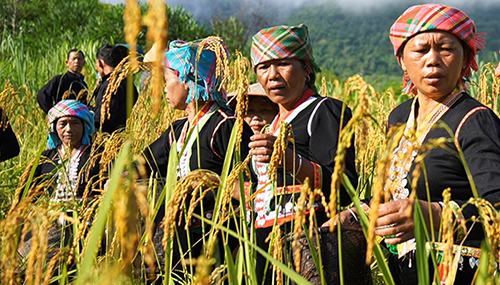The Khmu (/kəˈmuː/; Khmu: /kmm̥uʔ/ or /kmmúʔ/; Lao: ກຶມມຸ [kɯ̀m.mūʔ] or Lao: ຂະມຸ [kʰā.mūʔ]; Thai: ขมุ [kʰā.mùʔ]; Northern Thai: ขมุ [kʰā.mǔʔ] ;Vietnamese: Khơ Mú; Chinese: 克木族; Burmese: ခမူ) are an ethnic group of Southeast Asia. The majority (88%) live in northern Laos where they constitute the largest minority ethnic group, comprising eleven percent of the total population. Alternative historical English spellings include Kmhmu, Kemu, and Kơbru, among others.
The Khmu can also be found in southwest China (in Xishuangbanna in Yunnan province), and in recent centuries have migrated to areas of Burma, Thailand and Vietnam (where they are an officially recognized ethnic group). In the People’s Republic of China, however, they are not given official recognition as a separate “national” group, but are rather classified as a subgroup of Bulang.
The endonym “Khmu” is suspected to stem from their word kymhmuʔ meaning “people”. Khmu also often refer to their ethnicity as pruʔ.
Geographic distribution
The Khmu were the indigenous inhabitants of northern Laos. It is generally believed the Khmu once inhabited a much larger area. After the influx of Thai/Lao peoples into the lowlands of Southeast Asia, the Khmu were forced to higher ground (Lao Theung), above the rice-growing lowland Lao and below the Hmong/Mien groups (Lao Sung) that inhabit the highest regions, where they practiced swidden agriculture. There are more than 568,000 Khmu around the world, with populations of 500,000 in Laos, 73,000 in Central Highlands of Vietnam, 10,000 in Thailand, 10,000 in China, and an estimated 8,000-10,000 in the United States.
The Khmu (Kobru) of Laos reside mainly in the North, ranging across 10 provinces. The Khmu form the largest ethnic group, outnumbering even the Lao, in five Northern provinces (Luang Prabang, Phongsaly, Oudomxay, Bokeo and Luangnamtha Provinces). The Khmu of Thailand are clustered in Nan Province near the Thailand-Laos border.
Most Khmu villages are isolated, and only slowly receiving electricity. In many areas the Khmu live alongside the Hmong and other regional minority ethnic groups. The Khmu in the United States originated as refugees from the Vietnam War. Most of these refugees settled in California, which is home to both the Khmu National Federation, Inc., and the Khmu Catholic National Center.
Many of the Khmu in Thailand have arrived recently from Laos and Vietnam, also as refugees from the Vietnam War and subsequent communist governments, although cross-border migrations into Thailand’s Nan, Phayao and Chiang Rai provinces for new farm land and work in the teak industry began as much as 200 years ago.
Subgroups
In their mountain refuges, the various Khmu settlements became isolated, surrounded and partially influenced by the dominant groups of their respective areas. Accordingly, the Khmu now recognize subdivisions among themselves which are differentiated primarily by dialect. These subgroups are called tmowy ([tmɔi]) in Khmu. Some of the larger tmowy are the Tmowy Mea [tmɔi mɛ], Tmowy Ksak [tmɔi ksăk], Tmowy Rok [tmɔi rɔk] (Lao: kha hok).[3][5] The Khmu north of the Tha River (nam tha), who often live in close contact with the lowland Tai Lü and Thai Yuan peoples, distinguish groups including the Tmowy Lü [tmɔi lɯʔ], Tmowy Yuan and Tmowy Khuen (Khuen is often a synonym for “Khmu” in general).
Language
Main article: Khmu language
The Khmu language belongs to the Austro-Asiatic language family, in which several closely related languages including Puoc, O’du and Kniang, among others, are grouped together forming the Khmuic branch. The many dialects of Khmu differ primarily in consonant inventory, existence of register, and the degree to which the language has been influenced by the surrounding national language(s). Dialects are, for the most part, mutually intelligible; however communication can be difficult between speakers of geographically distant dialects.
Origin
See also: Peopling of Laos
Khmuic peoples refers to a group of ethnicities of mainland Southeast Asia that speak closely related languages and follow similar customs and traditions. It is believed, based on linguistic, cultural and historical evidence, that these now-disparate groups are descended from a homogeneous ethnicity that may have been among the first populations to settle northern Indochina. This historical Khmuic people inhabited areas far larger than at present, including northern lowland areas of at least present day Thailand and Laos, until absorbed or pushed into mountainous refuges by successive Mon and Khmer empires and the later arrival of various Tai peoples.
source:https://en.m.wikipedia.org/wiki/Khmu_people

